Introduction
Pesticide enforcement and oversight in the state of Florida is managed by the Florida Department of Agriculture and Consumer Services. As part of those responsibilities, they routinely inspect facilities associated with pesticide use and storage. This publication will explain who may be inspected, why they might be inspected, and the process of that inspection. After reading this publication, all professionals working with pesticides and county Extension faculty should understand what a pesticide inspection looks like and be able to comply with state and federal requirements for using pesticides.
Who in FDACS does inspections?
The Bureau of Inspection and Incident Response (BIIR) ensures consumer protection, worker safety, and protection of the environment through inspections of entities that manufacture, sell, or apply pesticides, fertilizer, feed, or seed. Basically, if a facility or entity uses, sells, or stores pesticides, the BIIR has the authority to do an inspection. The BIIR is one of four bureaus within the Division of Agricultural Environmental Services. All four bureaus have an important role associated with pesticides. This division handles licensing, pesticide registration, laboratory analysis of products for accuracy of ingredients, water, soil, and other monitoring services, and inspection. All of the bureaus work hand-in-hand to ensure every aspect of pesticide use and registration in the state follows federal requirements, with enforcement and inspections being a key component of that process.
Why are inspections conducted?
Inspections can either be done at random, through routine enforcement efforts, or based upon a specific request or notification of possible violations. Beyond checking for violations, inspections can serve as learning and teaching opportunities for employers, homeowners, and anyone associated with pesticide applications. These inspections ensure all appropriate rules and regulations are followed, thus helping protect people and the environment. All three of Florida’s statutory chapters (Chapters 388, 482, 487) pertaining to pesticides give authority to conduct inspections. This includes anywhere from a small farm to a large pest control company treating lawns, and everything in between. If pesticides are used, inspections can be performed. To best understand the pesticide certification, license, or credential that corresponds to each statutory chapter, see the Pesticide License Key requirements and basic description of each category.
What is involved in an inspection?
An inspection can be as simple as confirming possible complaints, to a deep review of equipment, spray records, certification, and training records, and beyond. Inspectors will complete official forms, take photographs, collect physical evidence, and do interviews. Records pertaining to pesticide applications and Florida rules regarding pesticides should also be made available to inspectors. The following sections will discuss each component of an inspection in greater detail with links to the individual inspection forms.
Inspector Identification
An inspector will introduce and identify themselves with proper credentials, such as a badge with their name and photograph. They will go on to explain the reason for their visit and may begin cursory questions at that time. An inspection might be coordinated ahead of time or can occur at any time without prior notification. It is important to make sure that all staff at the location understand the rules and procedures for an inspection. This includes knowing which forms the inspectors will use and walking through these forms prior to the inspection. This practice assures that the appropriate managers and related personnel can be contacted, and that the inspection will run smoothly. The following sections will cover examples of the forms that may be used and the type of information each attempts to gather.
Commonalities
Regardless of what type of pesticide regulated activity is being performed, there are commonalities among the inspection forms. All forms allow the inspector to document if the pesticide is classified as a restricted use product (RUP). This is important because the use of RUP pesticides requires certification, licensing, or credentialing for those using the product. There are instances where an unlicensed person may use those products under direct supervision, but there is specific training that must be documented. If RUPs are being used, an inspector will also ask about the training, licensing, and records related to this application.
Beyond records, licensing, training, and RUP use, all inspectors will verify that all products are used according to the label. The label is the law. This might mean checking that proper Personal Protective Equipment (PPE) is on-site, that its proper use can be demonstrated, and that it is stored properly. Inspectors can also ask about pesticide use rates, mixing methods, and where a product was used. Overall, they are trying to ascertain that all applicators can read, understand, and follow the pesticide label.
Finally, an inspector will review storage and disposal procedures. They are looking to make sure pesticides are stored in a secure manner that meets all label and other requirements. A clean, organized, secured/locked storage area indicates to an inspector that the location and its employees value safety.
Aside from these commonalities, each statutory chapter in Florida (388, 482, 487) has its own unique set of forms. To better understand what types of activities fall under each of these chapters, it may be helpful to use the Pesticide License Key. This will ensure the right forms are being viewed.
Chapter 487 Forms – Restricted Use Pesticide (Agriculture)
Although listed as a 487 form, the Pesticide Dealer Inspection Report (Figure 1) applies to all pesticide dealers in the state of Florida. This inspection is done at the various points-of-sale where pesticides, particularly RUPs, are sold. Making sure those who sell pesticides are in compliance certainly helps to ensure those who buy them will be as well. This form asks if RUP products are sold, whether all products are stored securely, and how the business guarantees that ONLY certified purchasers are buying RUP products. Furthermore, it confirms that some of the product-specific restrictions are met as well. Finally, an inspector must ensure proper records are kept and available for review.
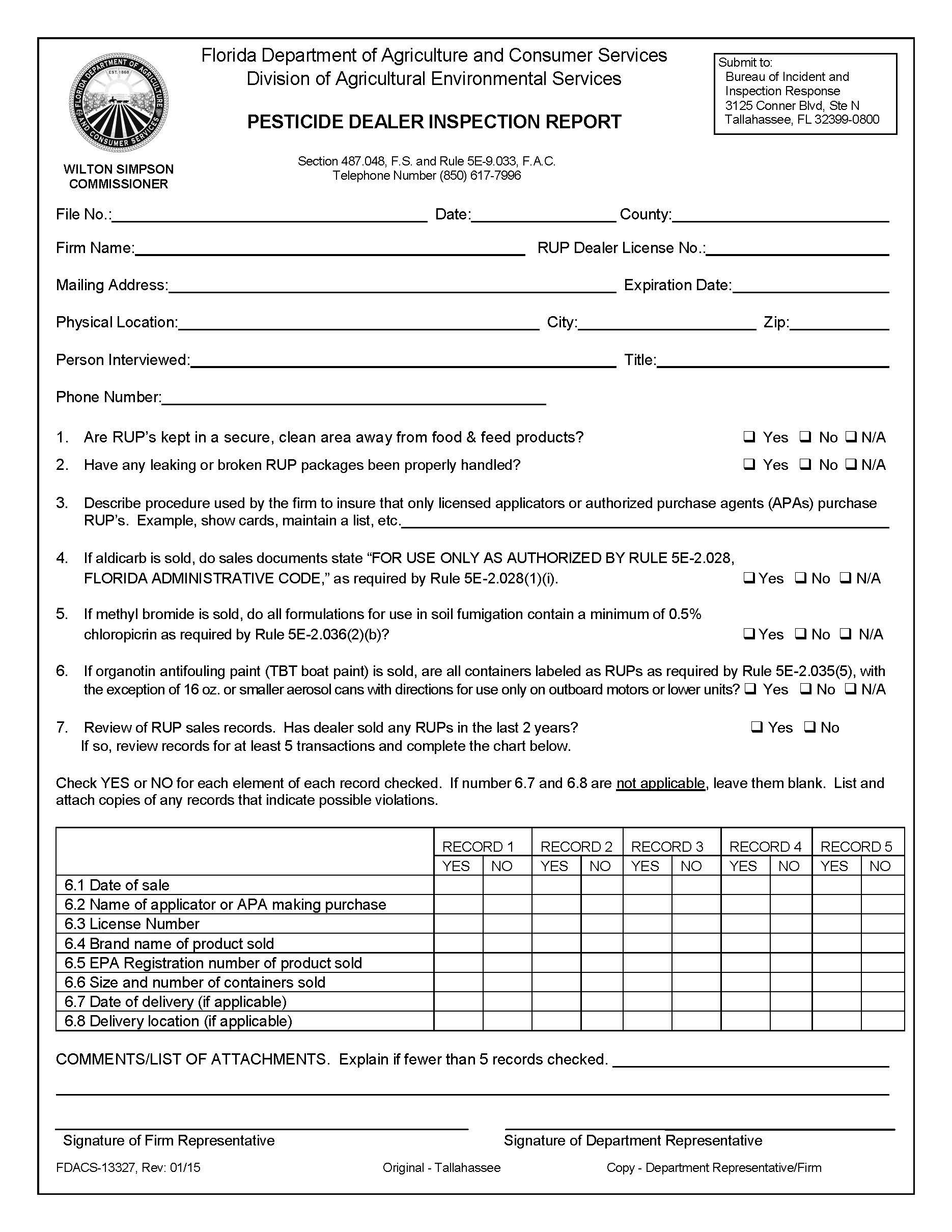
Moving from the point-of-sale to the individuals involved in pesticide use, chapter 487 also includes the Pesticide Use Inspection Report (Figure 2). The inspector will identify the location and company being inspected. This involves gathering basic information related to specifically who and what is being inspected. From there the checklist involves looking at how pesticides are stored and how they were used in the field, as well as confirming all licenses and certifications are in place. Additionally, the report will include “other relevant information” and signatures. This “other relevant information” or “background information” can become quite extensive as this section documents any conversation with the inspector, including interviews with all relevant personnel.
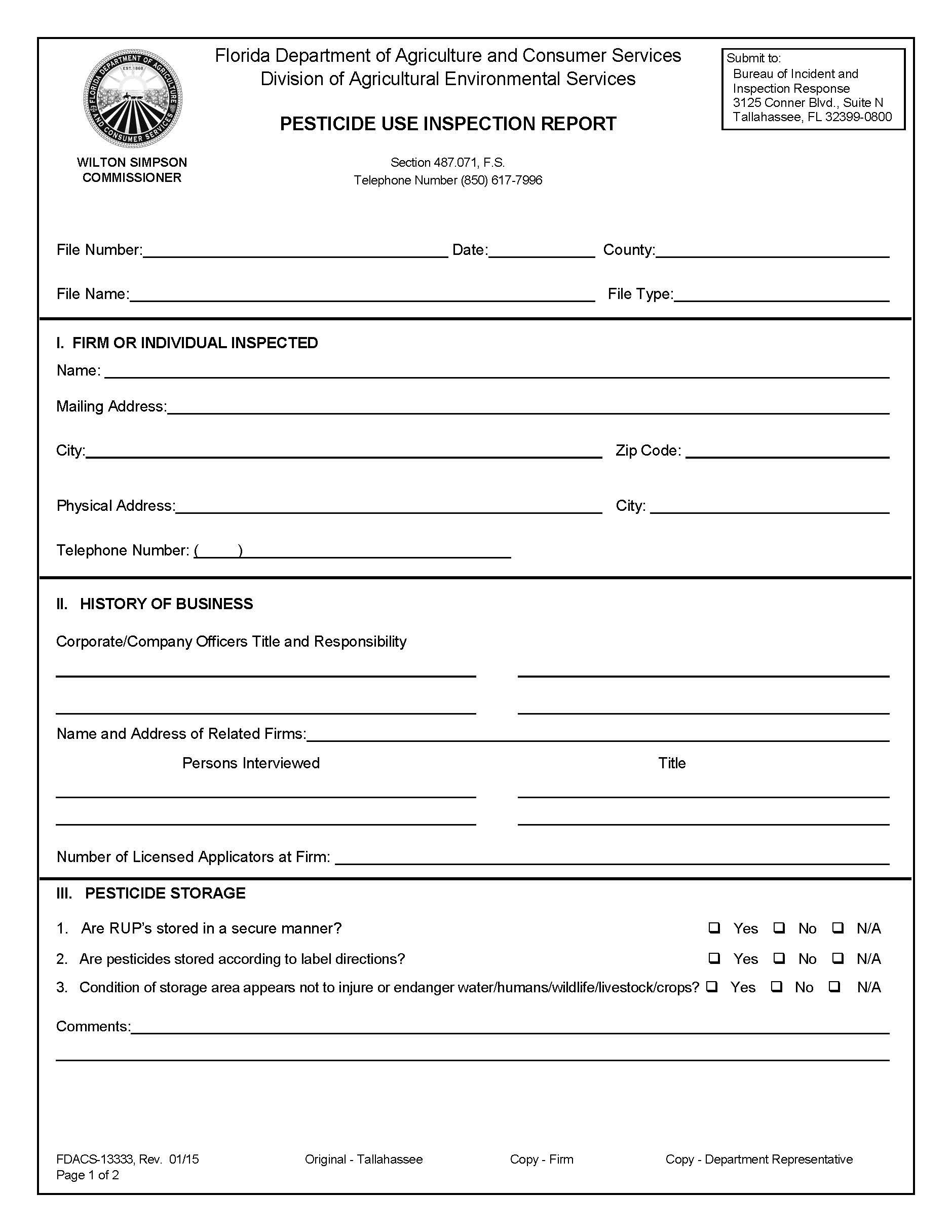
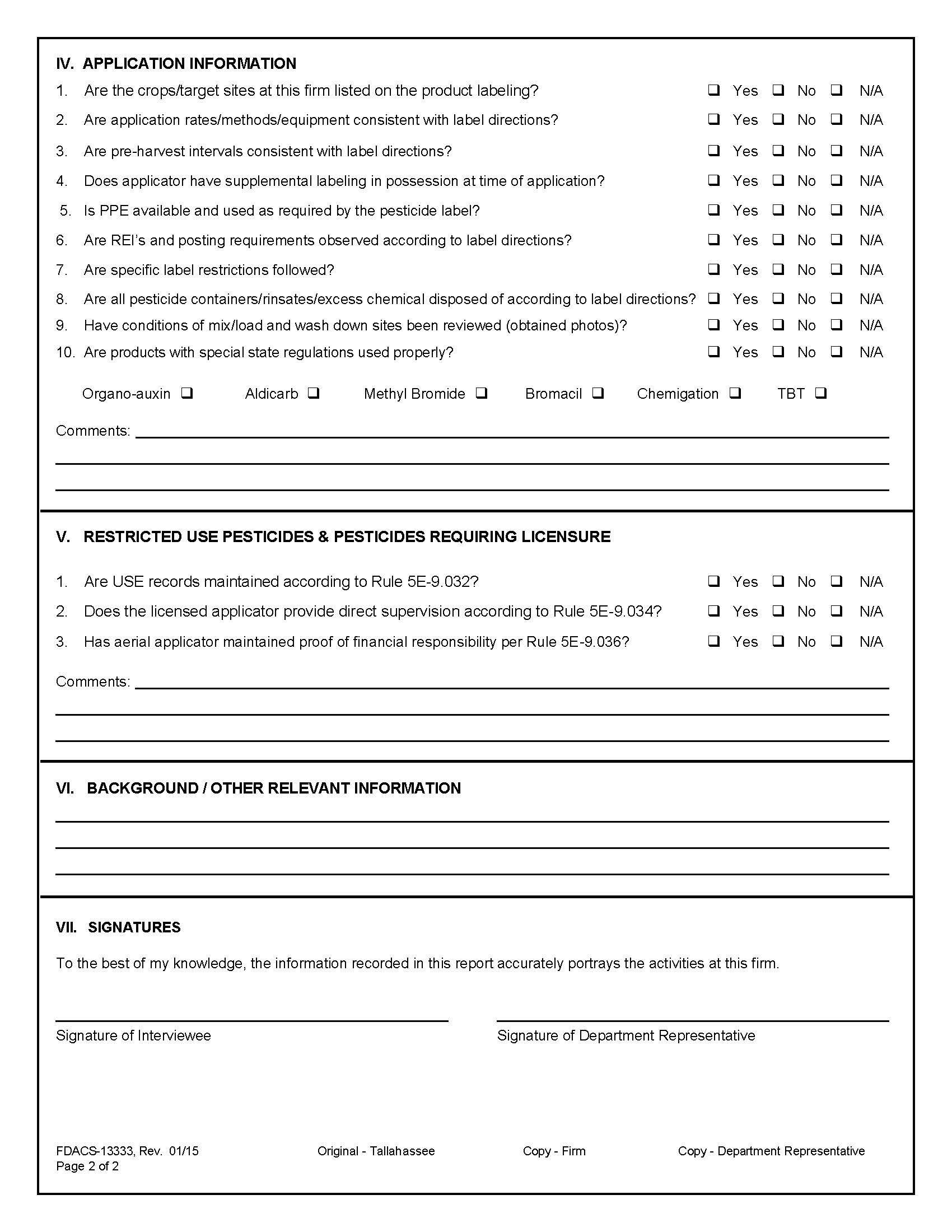
For businesses or operations that fall under the Worker Protection Standard (WPS), there are further inspections in addition to what has been described so far, that are required. These inspections will check that all aspects of WPS are in place and operating properly (Figure 3). The inspector will confirm that there is centralized posting of relevant information and that proper communication plans are in place. They will make sure that all relevant employees have proper training, and that proper decontamination supplies and procedures are in place. Additionally, the inspector will determine if the Restricted Entry Intervals (REIs) are properly maintained and communicated. Finally, the inspector will confirm records are being kept on-site for all pesticide treatments and all WPS training and procedures.
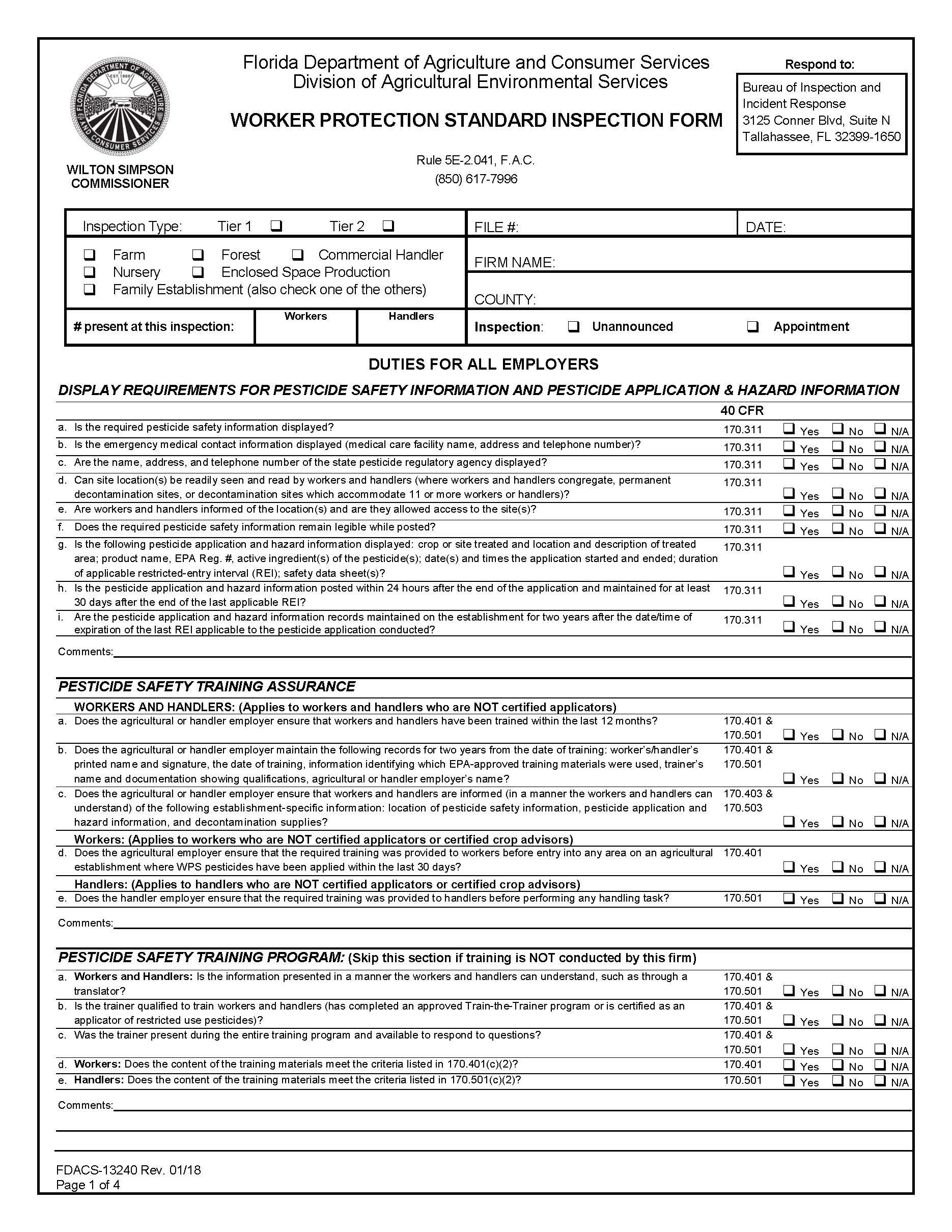
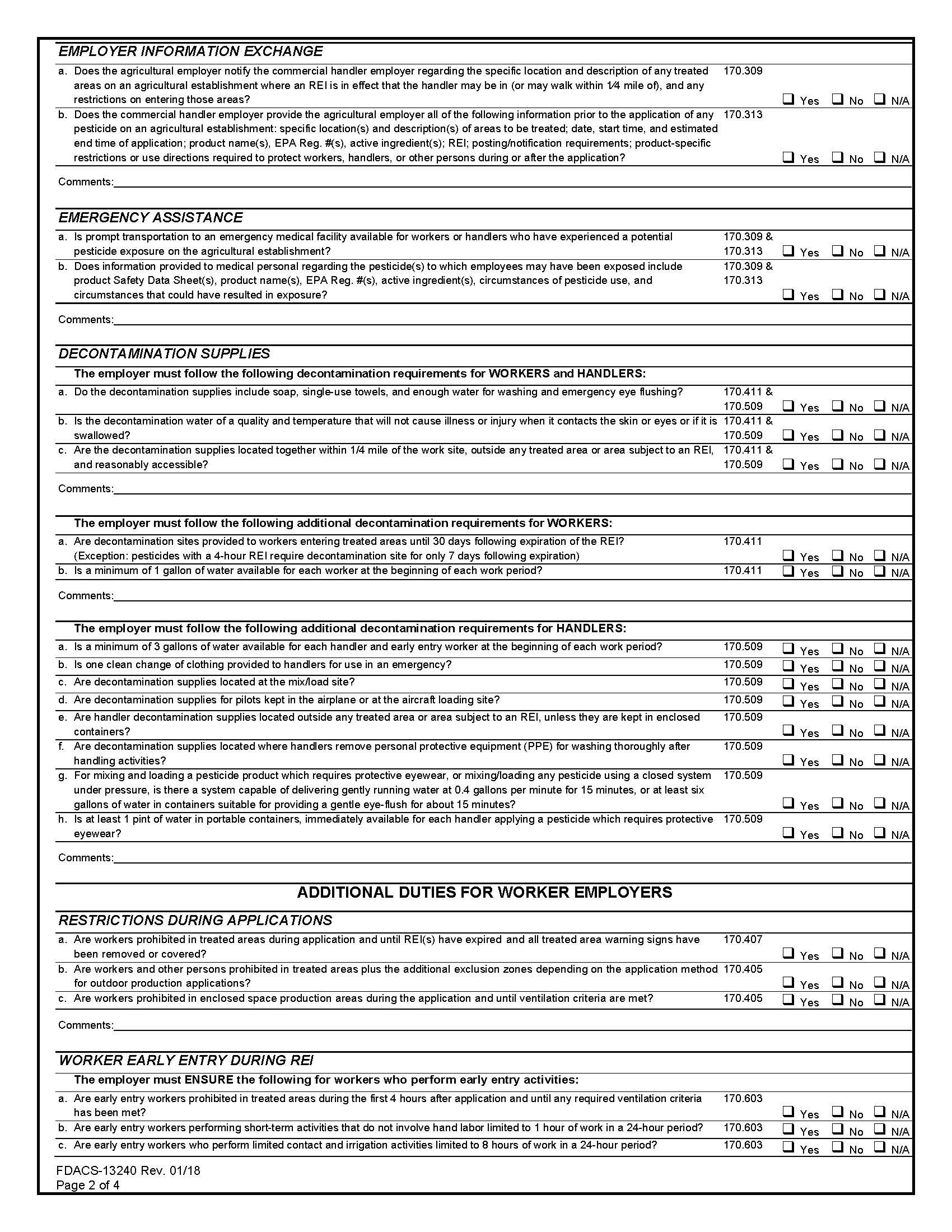

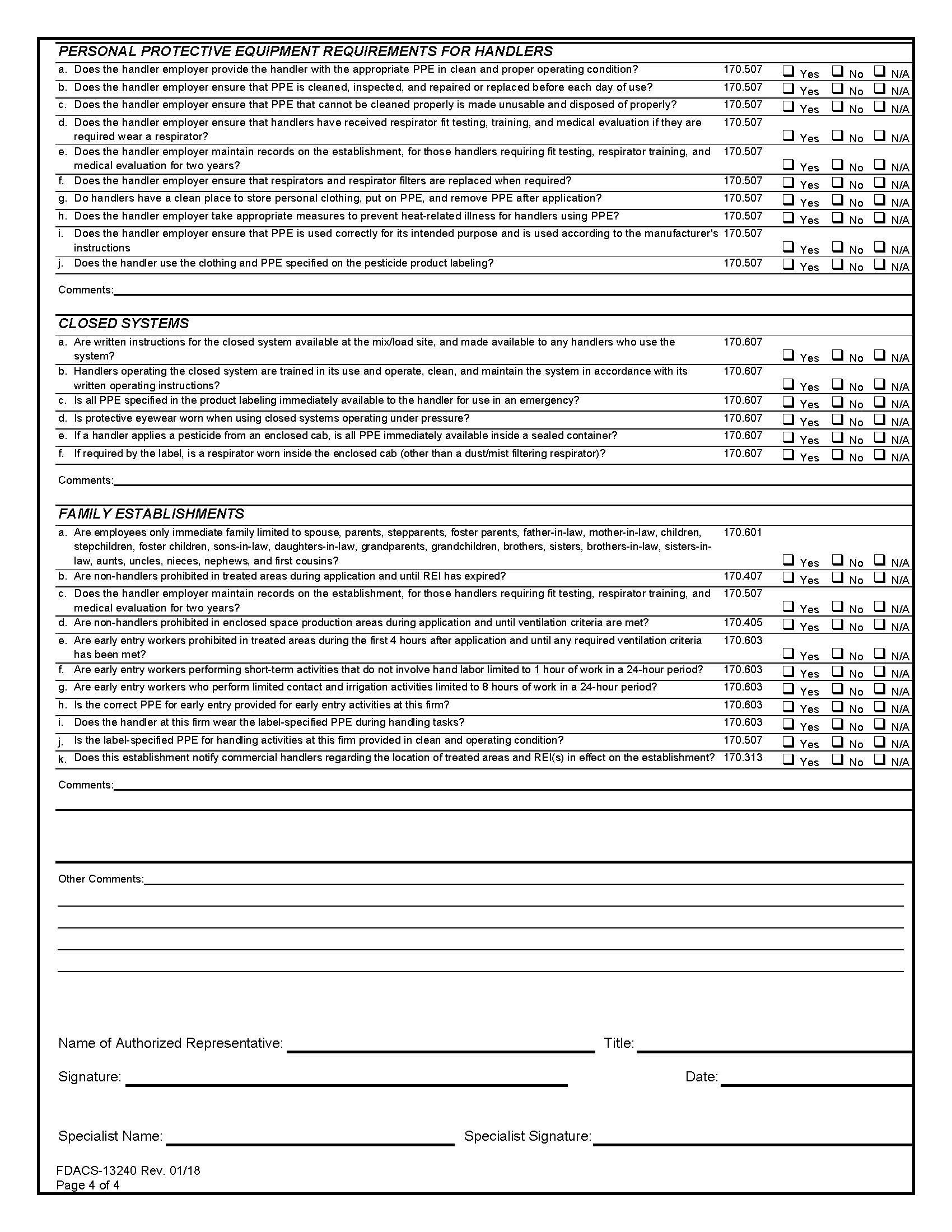
Chapter 482 – Structural Pest Control
Much like the 487 inspection forms, there are several forms for 482, starting with the broadest information and getting increasingly use-specific. The Licensee Inspection Pesticide Product Review (Figure 4) applies to any product used by someone certified in a category falling under chapter 482. It gathers basic information about the company using the product, what was used, how it was applied, and whether there were any misuses or label violations.
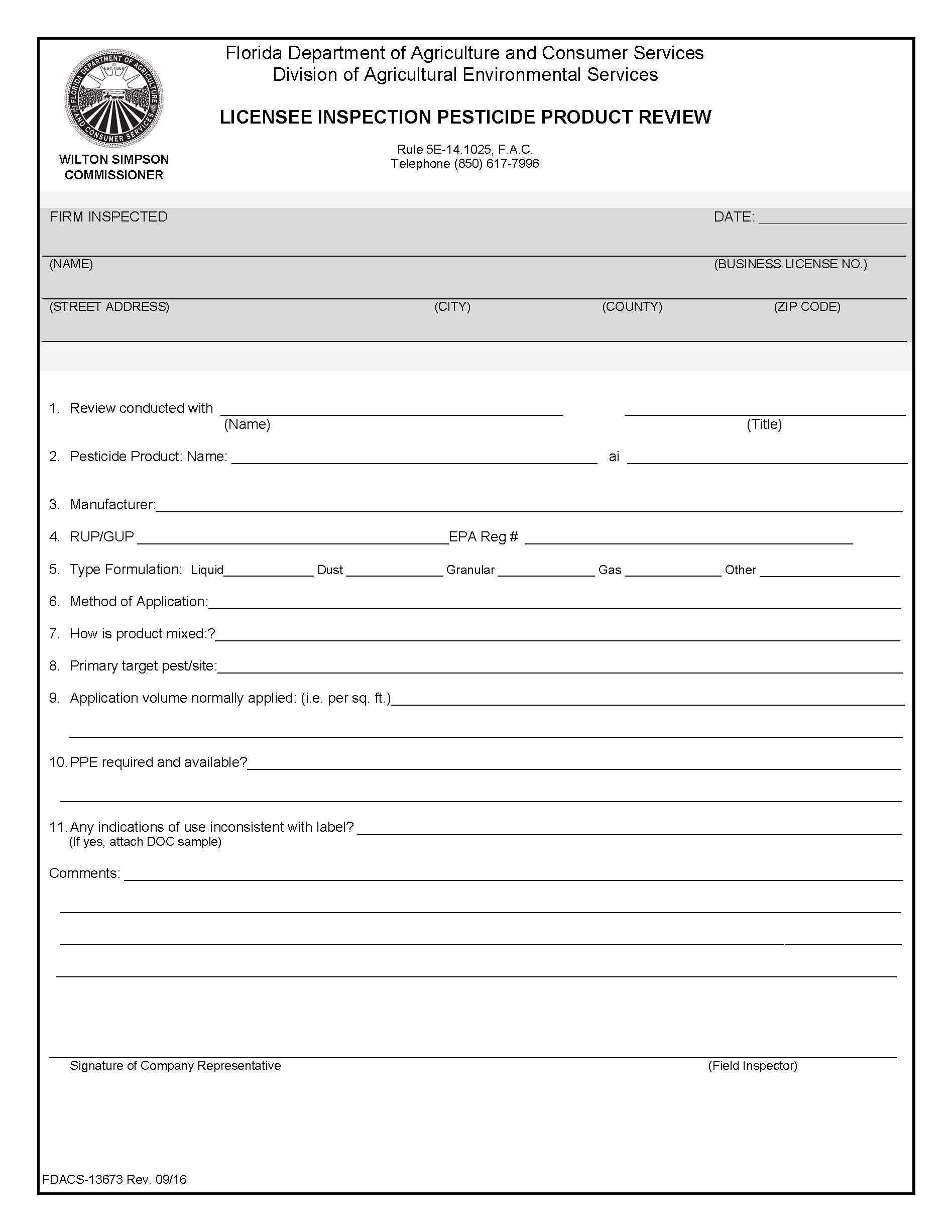
Facilities or offices from which chapter 482 work is performed, sold, or directed may also be inspected. This form is the Pest Control Business Inspection (Figure 5). This form checks for all relevant certifications, business licenses, insurance, advertising, notifications, and overall assurance that the facility can legally operate. Furthermore, it confirms that equipment is properly identifiable, as well as in good working order, and that fill locations and trucks all have an “air gap” to ensure pesticide mixture does not backflow into water supplies. Finally, the types of pesticides on-site are checked and referenced to the type of certifications held by applicators. Basically, the inspection confirms that applicators are certified and trained to use all products found on-site.

Like the previous form, there is also a Licensee Inspection: Termites and Other Wood-Destroying Organisms (WDO) Category (Figure 6). This is meant to take place on-site during activities related to termite and other WDO inspections and treatments. The form and inspection ensures all certifications are in place, forms are available for distribution, and the contracts in place meet all state laws and regulations.
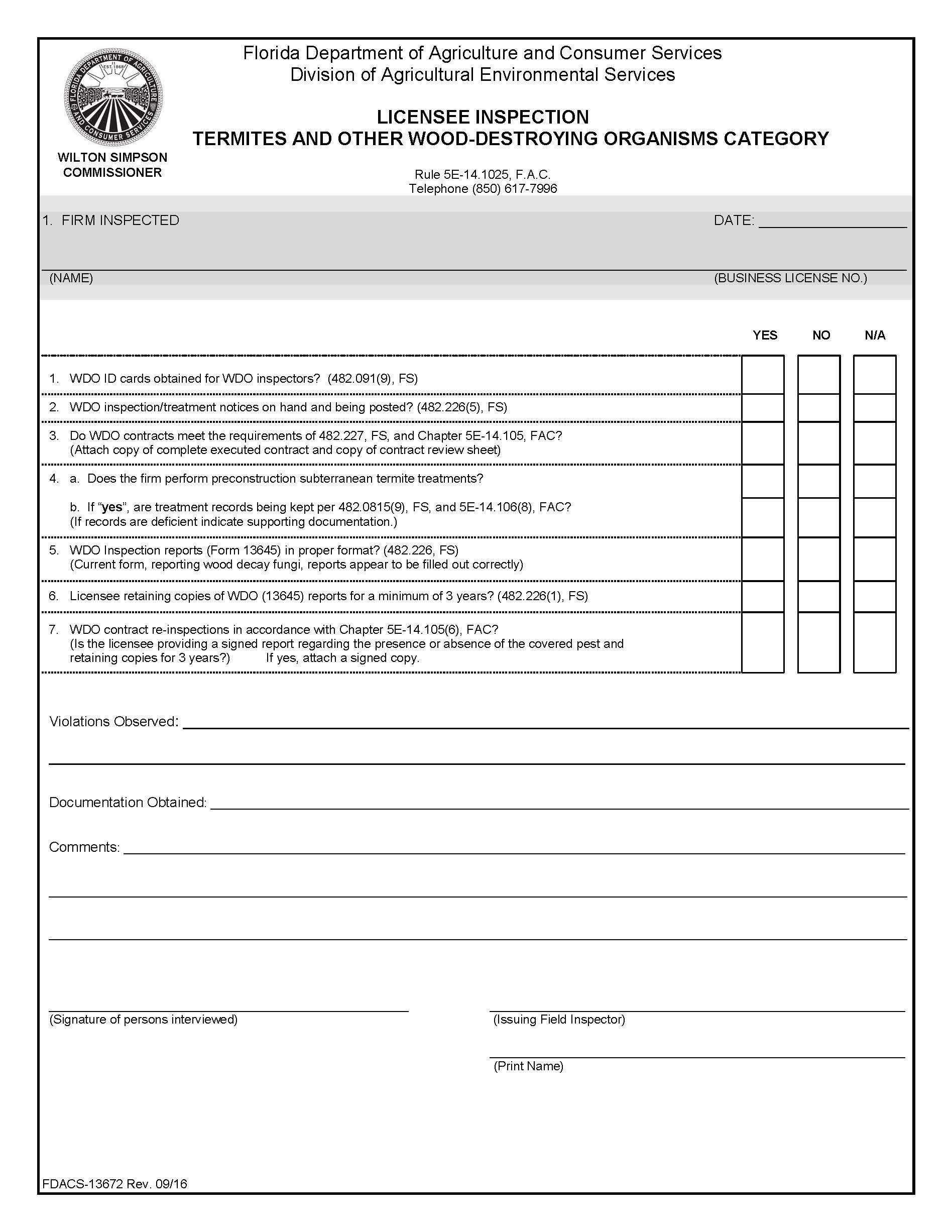
The next two forms under chapter 482 are for one of the most regulated categories, fumigation. The first is the Licensee Inspection: Fumigation Category (Figure 7) which maintains that all the proper certification, safety equipment, and signage are in place. Basically, it ensures that a fumigation could take place and meet all label and state requirements. The second form is the Fumigation Inspection Report (Figure 8), which reviews and confirms a past fumigation was performed correctly. This is one of the most detailed forms and covers all aspects of a fumigation.
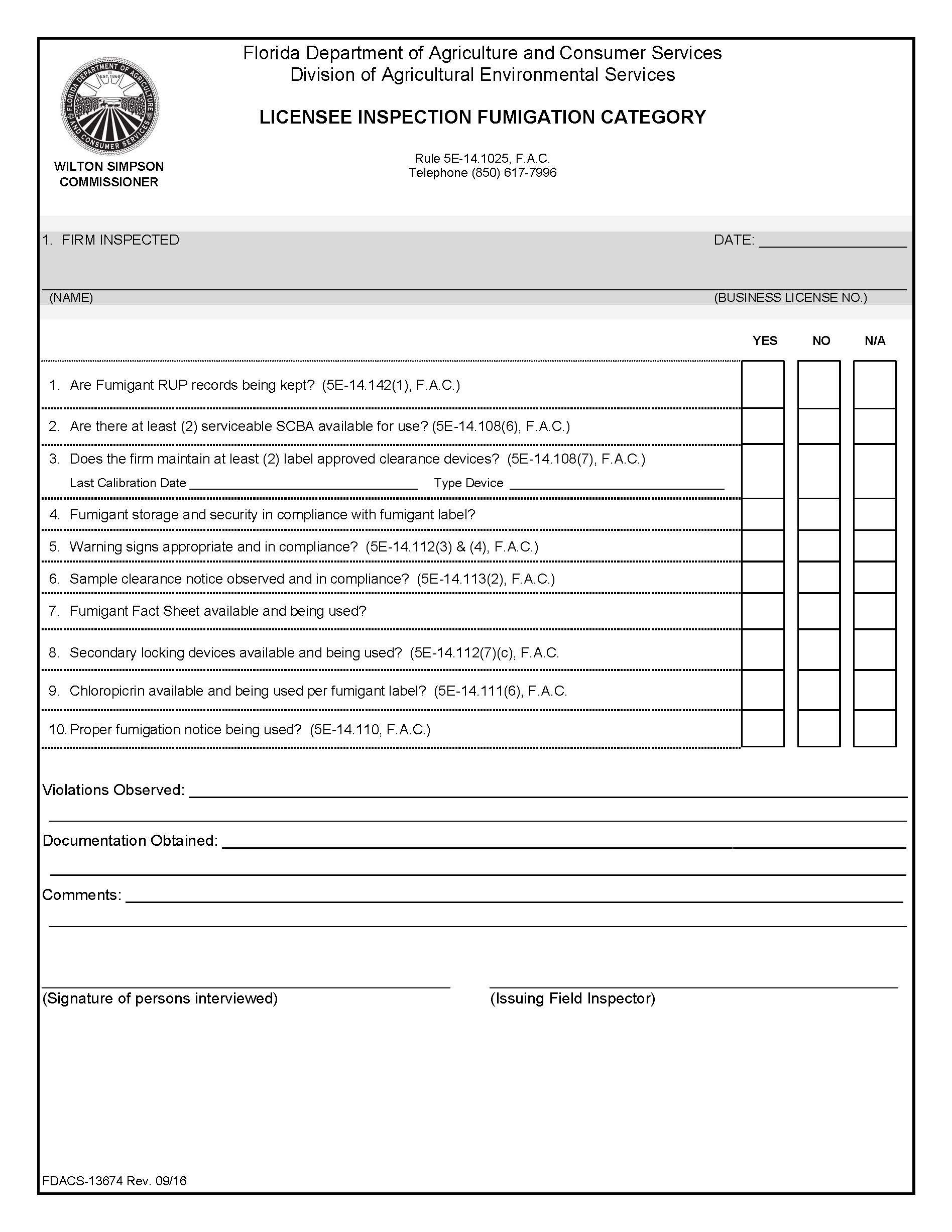

One type of inspection that may occur in both the field and at the place of business is the Pest Control and Limited Landscape Maintenance Service Vehicle Inspection (Figure 9). This inspection is meant to ensure that all vehicles are properly identifiable with personnel holding the proper credentials. Additionally, the vehicle is inspected to identify which chemicals are on board, determine if they can be secured properly, and confirm that the proper PPE is available. Finally, depending on the type of work, the inspector checks that all necessary certifications are held and proper restrictions are followed. For instance, if applicators are only certified for limited landscape maintenance work, the inspector will check to see that they only carry products with the signal word “Caution.”
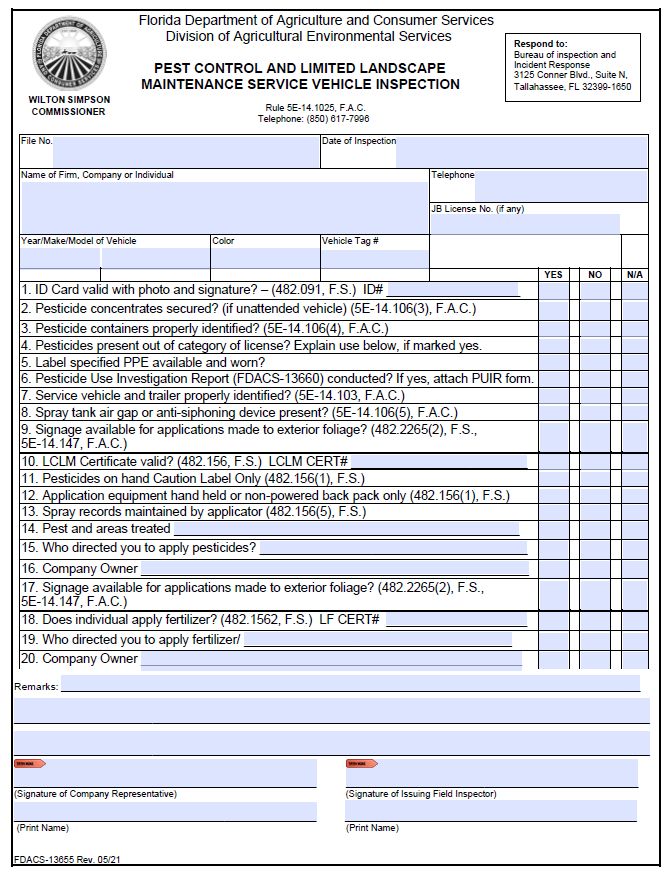
Chapter 388 – Mosquito Control
For those involved in mosquito control, there is the Mosquito Control Pesticide Use Inspection Report (Figure 10). Like the previous pesticide use forms this is commonly used when inspecting a facility from which mosquito control is based. The inspector will begin with the details of the facility, including how many licensed applicators are present, full time versus part time, and who is in charge. They will then inspect the facility to ensure all pesticides are stored and disposed of properly. Next, they will check that worker safety is covered through proper PPE and training and that records of all training can be provided. All equipment is checked to confirm it is in proper working order. This includes proper calibration according to label requirements for droplet sizes. Recordkeeping related to pesticide use is checked as well as the methods of application. Full compliance with all labeled uses of pesticide product is confirmed. Finally, the inspector will ask questions about compliance with the National Pollution Discharge Elimination System (NPDES) and whether all proper certifications and specifications are in place related to aerial aircraft.
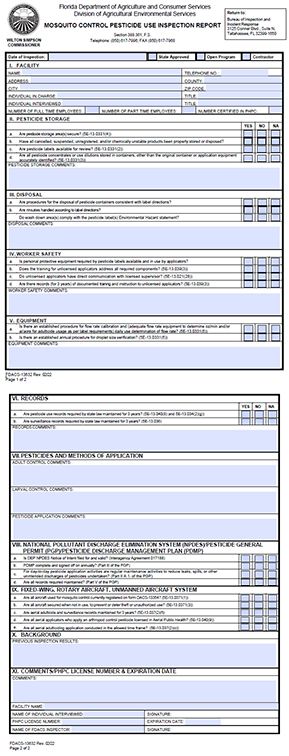
Credit:
Conclusions and Helpful Information
An inspection by FDACS does not need to be an overly stressful or frightening prospect. The best practice a manager could follow would be to use these forms to provide mock inspections on your own facility. All told, the first time that employees see these forms or answer these questions about the operation should NOT occur during an FDACS inspection. Using the forms provided in this publication will help ensure that the facilities, equipment, and employees are all in compliance with the rules. This will not only help with any inspections that might occur in the future but will sustain the operation as one that focuses on safety and makes it easier to comply. Staying in compliance is not simply a box to check or a burden to dread, it is an opportunity to ensure that all pesticides are used as safely and effectively as possible.
Resources
Pesticide License Key: EDIS Publication #PI292, “Finding the Correct Pesticide Applicator License in Florida” at https://edis.ifas.ufl.edu/publication/PI292
Direct Supervision: EDIS Publication #PI293, “Florida Rules for Direct Supervision of Unlicensed Pesticide Applicators” at https://edis.ifas.ufl.edu/publication/PI293
WPS: EDIS Publication #PI294, “Worker Protection Standards (WPS) Responsibilities and Compliance” at https://edis.ifas.ufl.edu/publication/PI294